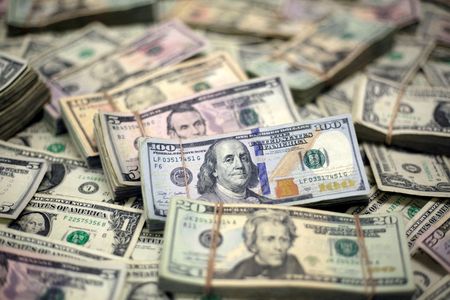By Ankur Banerjee
SINGAPORE (Reuters) -The dollar was steady on Tuesday and the yen inched away from one-month highs in cautious trading as investors braced for U.S. inflation data and reassess expectations of a large interest rate cut from the Federal Reserve next week.
A mixed labour report on Friday failed to make a clear-cut case on whether the Fed would deliver a regular 25 basis point (bps) rate cut or an outsized 50 bps one at its Sept. 17-18 policy meeting.
Traders are now waiting on Wednesday’s U.S. consumer price index report for further policy clues although the Fed has made it clear employment has taken on a greater focus than inflation. The headline CPI is expected to have risen 0.2% on a month-on-month basis in August, according to a Reuters poll, unchanged from the previous month.
A weaker-than-expected report could bolster market expectations of a 50 bps cut, but a steady reading may leave the 25 bps versus 50 bps debate unresolved, according to Charu Chanana, head of currency strategy at Saxo.
“Overall, the USD is expected to trade sideways to higher, as current Fed easing expectations still appear excessive.”
China’s yuan eased slightly Tuesday, but losses were capped by better-than-expected export data. [CNY/]
Imports, however, missed forecasts and grew just 0.5%. That follows lower-than-expected inflation data published on Monday, highlighting still weak domestic demand.
Investor focus will also be on the highly anticipated televised U.S. presidential debate later on Tuesday that could weigh heavily on the November election.
The dollar was little changed at 143.10 yen, giving up gains from earlier in the session but was still creeping away from the one-month low of 141.75 touched on Friday. The greenback fell 2.7% last week against the yen.
The dollar index, which measures the U.S. currency against six rivals, was at 101.61 after rising 0.4% on Monday.
Markets are currently fully pricing in a 25 bps cut next week, with a 50 bps cut priced in at 30%, down from as high as 50% on Friday, CME FedWatch tool showed.
For 2024, traders expect 110 bps of easing, up from around 100 bps from the remaining three meetings.
Fed policymakers last week signalled they are ready to kick off a series of rate cuts, noting a cooling in the labour market that could turn more dire in the absence of a policy shift.
“Fed rate cuts are coming,” said Anthony Saglimbene, chief market strategist at Ameriprise Financial.
“But it’s less important whether the first cut is 25 or 50-basis points, in our view. The more important dynamic for investors to keep tabs on is whether rate cuts take the escalator or elevator down from there.”
Meanwhile, the euro was last at $1.1039 after dropping nearly 0.5% on Monday ahead of the European Central Bank policy meeting on Thursday where the central bank looks all but certain to cut rates again.
The spotlight though will be on the messaging from the central bankers. Traders are pricing in 63 bps of easing this year from the ECB.
Markets on the other hand are anticipating 47 bps of easing from Bank of England in 2024 and the divergence between the U.S. and UK rates led sterling to touch a one-year high in August, although the pound has eased a bit since then.
The pound last fetched $1.307, having touched a near three-week low of $1.3058 earlier in the session ahead of a slate of labour and wage data later in the day that will help influence policy moves from BoE when it meets next week.
Data on Tuesday are expected to show robust employment growth and a further moderation in pay growth.
In other currencies, the Australian dollar was last at $0.66655, having touched a more than three-week low of $0.66445. The New Zealand dollar last bought $0.6148, staying close to the three-week low it touched on Monday. [AUD/]
(Reporting by Ankur Banerjee in SingaporeEditing by Shri Navaratnam and Kim Coghill)





